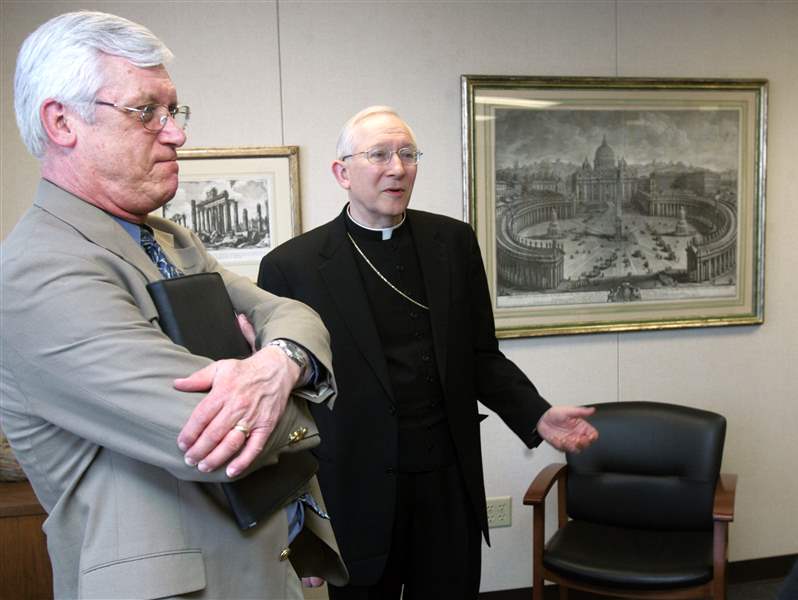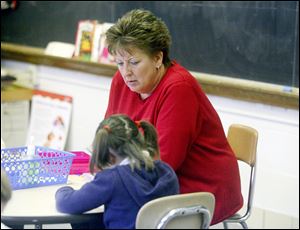
Catholic schools in Toledo area adjust to enrollment losses
2/16/2010
Jack Altenburger, superintendent of the Catholic Diocese of Toledo, and Bishop Leonard P. Blair are charged with deciding how diocesan education resources will be used.
The Blade/Lori King
Buy This Image
When Bishop Leonard P. Blair attended Catholic school in the Detroit area as a boy, tuition was just a couple dollars a month for him and his sister.
He remembers going to the office every month with his index card and $2.50 in hand to pay for their education, which was provided mostly by nuns.
That's no longer the case.
"Today you can imagine how complicated life has become," Bishop Blair said. "The costs were very minimal back then, but even today if we had all those sisters the cost would still be considerably higher because life is more complicated."
The Catholic Diocese of Toledo is trying to adjust to the changes that have led to decreases in enrollment and increases in the cost of a faith-based education.
Not only are there now mostly lay people teaching in Catholic classrooms who receive salaries and benefits, but family demographics are much different, Bishop Blair said.
Generations of families used to attend a church and its school, but now families are much more transient.
Parents have fewer children and more education options that don't require paying tuition that increases every year.

Sandy Huhn leads a kindergarten class at Little Flower. Thirty years ago, such classes were typically taught by nuns. Today, most Catholic teachers are lay people.
A decline in active participants in the Catholic faith also is having an effect, Bishop Blair said.
Altogether, the changes have contributed to a decline in total enrollment in the 19-county Toledo diocese of more than 9,400 students in kindergarten through grade 12 in the last decade - a 32.5 percent drop.
Over the last 30 years, the number of Catholic students decreased from 35,356 throughout northwest Ohio in the 1979-80 school year to 19,572 this year.
There also are 20 percent fewer school buildings than there were a decade ago, with planned collaborations in the works for further reductions from the 67 elementary schools and 14 high schools.
The bishop recorded a video shown recently to parishioners during Catholic Schools Week explaining the challenges of providing Catholic education but committing to its importance.
"My message was not meant to be a gloomy one," he said. "It's important for people to be informed about where things stand with regard to Catholic schools in our diocese today. Are there challenges? Yes. There are big challenges, and I tried to highlight some of them."
It's important to communicate the importance of faith-based learning and to move forward with informed financial decisions to maintain strong Catholic education, he said.
One answer the diocese has is the consolidation of parish schools to alleviate the pressure on a church to subsidize them.
In Toledo next school year, Little Flower and Our Lady of Lourdes will combine into a yet unnamed school at the Little Flower campus, 5522 Dorr St., and there is a plan for St. Catherine and St. Clement to consolidate in the St. Catherine building, 1155 Corbin Rd.
In Fremont and Tiffin, the Catholic schools are reorganizing into one umbrella school with different campuses that will consolidate over time.
The Kateri Catholic school system in eastern Lucas County is taking the same approach.
"We have a lot of creative thinking going on where schools have come together in some consolidation," Bishop Blair said. "Today's circumstances call for cooperative effort. These are, I think, very positive things. You only move forward if you recognize the realities of today and you try to plan accordingly."
Not all of the changes have been well received by parishioners and parents.
Dan Wilcox, whose two daughters are in preschool and second grade at St. Clement, said he and other parents are upset their school is closing.
"As a business person, I understand the financials of it. I understand, but I'm not really happy about the way it was done," he said.
Some St. Clement parents said they were pressured to send their children to St. Catherine to make the diocese plan work, he said.
He said he will try to get his daughters into Blessed Sacrament, which is closer to his home and was their second choice when first looking at Catholic schools for the girls, now 5 and 7.
"They forget sometimes that it's our children, and we're going to decide where to send them," Mr. Wilcox said.
Other parents in the St. Clement area have opted to send their children to the Washington Local public schools because of uncertainty and confusion with the Catholic schools.
"There's always a concern that when you do something new, there will inevitably be some people who are not happy with it and may choose not to do it," Bishop Blair said. "But I would certainly hope and I'm confident that a greater number of people will be part of this. It is working in other places in the diocese and we're hoping it will work here in Toledo as well."
One of the largest changes in Catholic education is its teaching staff.
In the "old days," nuns taught most classes as part of their faith and mission, but today's faculty are 95 percent lay people with salaries and benefits, said Jack Altenburger, superintendent of the diocese.
"A large percentage of the faculty were sisters, and now it's rare to even find one," he said. "In those days, 30 years or so ago, the sisters basically donated their time. The cost of labor was so small that the cost of running a school was so small."
While personnel costs contribute to a majority of the expenses for the Catholic schools, the teachers are not paid high salaries.
Salaries for Catholic elementary school teachers are 67 percent of those for their colleagues at public schools; pay for high school teachers is about 72 percent of that in public schools, Bishop Blair said.
To combat the increasing costs, the diocese has been raising tuition an average of 3 to 4 percent a year.
The cost of a parish elementary Catholic education averages $2,000 a year, for a parish high school $4,000 annually, and an average of more for Toledo high schools not connected to a church. But that tuition doesn't provide enough funding to run the schools - just 40 percent for elementary schools and 75 percent for high schools.
The economy cannot be ignored.
Mr. Altenburger said his office often gets calls from families who want a Catholic education for their children but struggle to make it happen.
The "One Faith … Many Blessings" scholarship endowment fund is a diocese- wide way to assist families. This school year, 205 scholarships through that fund were awarded.
Although that is good, Mr. Altenburger said, it doesn't begin to address the issue of 1,000 applications.
Catholic schools do not receive much state funding, but what they do get was significantly cut in the current state budget, Mr. Altenburger said.
While public districts took a 1 percent or 2 percent cut, the private schools took a 15 percent hit, he said.
The future of Catholic education depends, local leaders said, on the diocese explaining and promoting the benefits of a Catholic education and working to provide that in the most economical way possible.
The diocese encourages parent choice and education options, Mr. Altenburger said, and hopes Catholic families will choose its faith-based curriculum.
"The primary mission we have is passing on the faith so we try to emphasize to every teacher coming into our buildings that every teacher is a teacher of religion, it's not just the religion class where the students get that. They need to have that infused in every single classroom," he said.
"Religion is not something you just do for an hour on Sunday nor is it something you do for one class period out of eight during the day. It has to be part and parcel of everything."
That enrichment of faith in learning is what makes Betsy Barone so passionate about Catholic education for her five children ages 7 to 16.
"We feel it's a gift that is going to last a lifetime for them. It is something I am passionate about. It's all I want for my children," she said.
While her neighborhood public schools in Perrysburg are good, Mrs. Barone has chosen St. Rose, St. Ursula Academy, and St. Francis de Sales High School for her children for the religious education in the curriculum.
Mr. Altenburger emphasized the faith-based aspects of diocesan schools.
"We say we're different by design. So my question to teachers is how is your math class different than the public school math class down the street," Mr. Altenburger said. "And if they can't answer that, then my question is why would I as a parent pay tuition then if it's exactly the same?"
While Catholic education is changing and enrollment is going down, Mr. Altenburger makes a point of saying fewer students does not mean a reduction in the quality of the education.
"The primary mission of passing on the faith is just as strong as ever," he said. "It doesn't deal with the bricks and mortar, it deals with what happens inside the classroom."
Contact Meghan
Gilbert-Cunningham at:
mcunningham@theblade.com
or 419-724-6134.